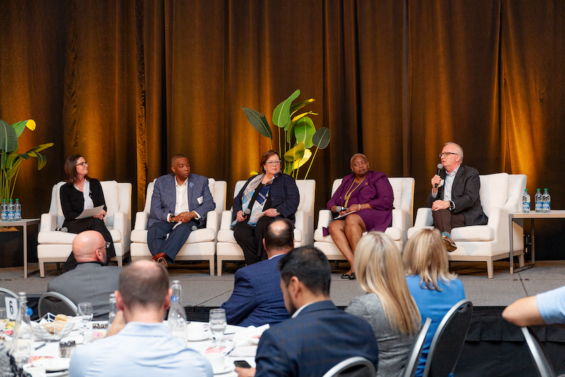Higher ed leaders share workforce solutions

A panel of Pierce County’s higher education leaders took the stage at the 2024 EDB Annual Meeting to discuss the state of workforce preparedness in the South Sound and what organizations can do to meet the difficult challenge.
WorkForce Central CEO Katie Condit moderated the panel discussion, which featured:
- Pacific Lutheran University President Allan Belton
- University of Washington Tacoma Chancellor Sheila Edwards Lange
- Tacoma Community College President Ivan Harrell
- Clover Park Technical College President Joyce Loveday
Addressing underemployment
More than 450,000 people are part of the Pierce County workforce, yet 180,000 are underemployed, Condit said. Pierce County’s higher education institutions have taken action to address the gaps:
- In response to a serious nursing shortage, PLU introduced an accelerated Bachelor of Science degree in nursing delivered on-site and online. To address health care inequities and provider shortages, the university recently announced the Partnership for Health Innovation. MultiCare Health System will build a new medical center on the PLU campus, and Washington State University Elson S. Floyd College of Medicine will send residents to Pierce County so nurses and future doctors can learn alongside one another.
- In addition to working with companies and other partners to develop short-term credentials and certificates, UW Tacoma faculty are looking at regional economic development data to determine the next degrees the university should offer. UW Tacoma continues to expand its K-12 partnerships to ensure students are prepared for and excited about jobs of the future. Through its Pathways to Promise program, the university offers guaranteed admission to students from Pierce County K-12 schools.
- With a focus on eliminating barriers to entry, CPTC has broken programs into “chunks” to ensure students receive industry related certificates to get them into the workforce earlier. CPTC also recently began to offer “college in the high school,” with a goal of moving kids through programs and into the workforce as early as possible with the least amount of expense.
- Transportation continues to be a significant issue for many in the community, and the greatest need is in Tacoma’s East Side. TCC took education to the community, partnering with a local church to offer its 10-week EMT program for working adults and providing an ambulance as a mobile laboratory.
Diversifying pathways
Panelists cited examples of how they are creating more pathways for students, and partnering with organizations, to create a more diverse workforce:
- CPTC focuses on guiding students into high-wage-earning fields. When individuals are drawn to more traditional, lower-paying careers, advisors help create a pathway to a degree to help them advance in their careers.
- PLU offers 253 PLU Bound Scholarships, which are awarded to qualifying college-bound students free tuition for their four years at the university.
- UW Tacoma continues its work to connect students of color, particularly in STEM, with large employers. Last year, Boeing brought hiring managers to the campus where they screened hundreds of students, conducted interviews and made on-the-spot job offers. Boeing plans to repeat the event this year. UW Tacoma also connects students with small businesses that offer internships that can lead to employment.
- One of the TCC’s health care partners recognized the need to increase diversity at the nursing assistant’s level. They hired high school graduates and brought them in as paid NARs (Nursing Assistants-Registered). TCC compressed its Nursing Assistant Certified program from 10 to 5 weeks, and the company paid for their employees to attend the program and become certified.
Dealing with generational differences
For employers navigating the challenges of generational differences in the workplace, panelists offered some advice:
- Belton: “Today’s students want a very clear pathway through an institution into one of your organizations, and they want another plan if they change their mind. When you are hiring them, be thinking 2-3 years out.”
- Harrell: “Openly acknowledge that there are generational differences and have conversations about them. What you may see as conflict in the workplace may be a different way of doing things. For example, our students and younger employees at TCC are very keen on work-life balance, mindfulness and how their jobs help them live their purpose.”
- Edwards Lange. “The younger generation wants to know what your company stands for, what you’re doing in the community and how that aligns with what they care about. They also want a lot more flexibility in their lives. Think creatively about how you can offer that.”
- Loveday: “When I think about what I want our students to experience when they step into a career, I ask myself if I’m providing that for new employees who come to CPTC. What I want for them is a place where they belong, where they have a mentor and opportunity for growth and professional development, and where they are seen. If we focus on those things, we will have a workforce that is content and engaged.”
Partnering to improve the workforce system
For organizations looking for workforce solutions, panelists collectively offered a clear message: If your organization has a workforce need in a particular area, talk with your local colleges.
“Let’s figure out how we can continue to partner in ways that are meeting your specific needs as employers,” Harrell said. “And to be true partnerships, recognize that you need to bring some things to the table as well.”
“This is a time of change in higher education,” Loveday said. “All of us are looking at how we can better serve and support you.”